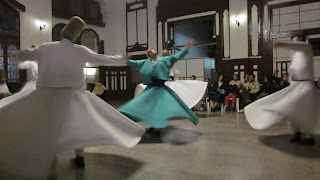I remember reading the
play: Dance like a Man, by Mahesh Dattani,
about a man who wants to perform the dance Bharatnatyam
. He is met with scorns and rebukes and he ends up mocking his
partner, a female dancer saying that “men love watching
her body and not the dance itself”.
I
have often thought about this line.
In
Indian context, most of the recent forms of formal dance are
performed by female dancers, They do have male dancers but they are
insignificant in numbers. However, if one counts the various
non-formal dance forms, which includes the tribal as well other forms
of dances like kathakali( masked dance) which have existed in Indian
subcontinent for centuries one would find that most of these dance
forms were male-dominated. These were more in the terms of theatre
which were either used as story-telling or for crowd gathering.
On
this note I would like to bring the readers to Cairo and Egyptian
dance forms. I am yet to see a belly dance live. I have heard so much
about it and have seen it in so many TV shows that I am dying to see
it. But there is a disdain for women who perform these dances, these
are considered to be women of desert and they are still seen as
nomads. Belly dancing is still considered to a low class profession
and is restricted to women from lower classes. This was in sharp
contrast to the popular dance form Tanoura, which was performed by
men. These are also people from lower class but they are considered
as artists.
I was sitting in Cairo
watching Tanoura dance and its similarity to Turkish Mevlana struck
me. No doubt they were similar, other than the fact that one was fast
and other slow, there was not much of a difference. And I got into my
thinking mode... all these dance forms have similar notions, similar
dance steps, even similar backgrounds. Both were performed by men.
Note : I use similar and not same, because there was a BIG
difference. Mevlana was meant to be prayer whereas Tanoura dance was
more in the form of entertainment.
If
one goes back into history of these dance forms, they were both
formed along the lines of Sufi tradition. It is more in a devotional
form, where the soul is considered to connected with spiritual world.
Sufism is an offshoot of Islam which restricts dance and music,
basically any sort of entertainment. The very fact that women are not
seen as part of this tradition further signifies the male-dominating
approach of this dance forms. There is an imposition of protection of
women from the male gaze. It was fine for a man to be gazed and awed
but women had to be protected.
However
there are feminine aspects to it, one more factor which intrigued me.
There were men who took the lead as female figures, and who pretended
to dance like females. The dance tries to emulate the different
aspects of life, and thus includes the feminine virtues of the dance
forms. But why not women , why not just have women perform these
dances ?
Was the protagonist in
Mahesh dattani's play right in saying, “they just want to see your
body, and not the dance” ?
When
I was looking at the men performing this dance form, I did think
women would have done better. These men were definitely graceful and
some were very handsome , maybe it was my subconscious mind that
wanted to see a women performing it. I love Kathak ( a dance form
which involves a lot of twirling and dance steps) and I love watching
women perform it. And I prefer women because they are beautiful and
graceful. Maybe this is subconscious, maybe I was taught to
appreciate and view women like that, and see men as strong and
ungraceful.
I am
well aware of the fact that I am leading on to the discourse of dance
itself, maybe there is a history of dance, history of entertainment,
but this is just a blog and no more a thesis.
The
more regional dances I witness the more I fall in love with our past.
We had such wonderful beautiful dance forms. Today, they are all
restricted to some corners of tourist attraction. No one is
interested in them any-more. These artists are dying a slow death.
Their profession is dying. No one realizes this is a culture-cide of
a whole generation of work-ethics. Not everyone was meant to be doing
9-5 jobs. Not everyone was supposed to live a scheduled life. There
were souls, who had transcended these boundaries. There are still
souls who love art for the sake of art.
Maybe they do stare at
her body, but what if she dances for herself.
Maybe we all should
dance like a man, unaware of the stares and gaze.
Dance ,dance . Dance
like a man.







Bharatanatyam is actually considered a masculine dance, of course at some point it became a devdasi only dance, and then cleaned out and still mostly limited to women...There's a whole lot of classical forms, which prohibit women and are exclusive to men performing it. in kerala itself if you look at kathakali and kathak - originally male...women had to actually fight for this right...ironic.
ReplyDelete